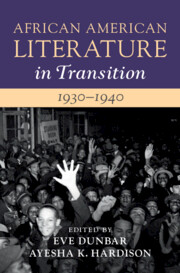Book contents
- African American Literature in Transition, 1930–1940
- African American Literature in Transition
- African American Literature in Transition, 1930–1940
- Copyright page
- Contents
- Figures
- Contributors
- Preface
- Chronology, 1930–1940
- Introduction
- Part I Productive Precarity and Literary Realism
- Part II New Deal, New Methodologies
- Part III Cultivating (New) Black Readers
- Chapter 7 Racial Representation and the Performance of 1930s African American Literary History
- Chapter 8 Black Print Culture of the 1930s
- Part IV International, Black, and Radical Visions
- Index
- References
Chapter 8 - Black Print Culture of the 1930s
from Part III - Cultivating (New) Black Readers
Published online by Cambridge University Press: 25 March 2022
- African American Literature in Transition, 1930–1940
- African American Literature in Transition
- African American Literature in Transition, 1930–1940
- Copyright page
- Contents
- Figures
- Contributors
- Preface
- Chronology, 1930–1940
- Introduction
- Part I Productive Precarity and Literary Realism
- Part II New Deal, New Methodologies
- Part III Cultivating (New) Black Readers
- Chapter 7 Racial Representation and the Performance of 1930s African American Literary History
- Chapter 8 Black Print Culture of the 1930s
- Part IV International, Black, and Radical Visions
- Index
- References
Summary
This chapter explores how the NAACP’s Crisis, the National Urban League’s Opportunity, Abbott’s Monthly and Challenge/New Challenge are representative of the more palpable literary focus on the experiences of the working classes and the poor that occurs in 1930s Black print culture. Along with novels, volumes of poetry, and coverage in the Black press more generally, these literary journals and magazines published explicit depictions of African Americans’ social conditions. As instances of how the New Negro reader of the Harlem Renaissance was recast throughout the decade, The Crisis, Opportunity, Abbott’s Monthly, and Challenge/New Challenge often targeted African Americans as working subjects and intended readers. As the chapter illustrates, the sections of literature, book reviews, editorials/criticism, and correspondence comprising these literary journalsʼ and magazinesʼ 1930s content allowed editors and writers to engage in work that both prioritized literary portrayals of African Americans’ inner lives as maids, cooks, day laborers, and the unemployed and expanded audiences for their developing literary tradition.
Keywords
- Type
- Chapter
- Information
- African American Literature in Transition, 1930–1940 , pp. 238 - 262Publisher: Cambridge University PressPrint publication year: 2022

